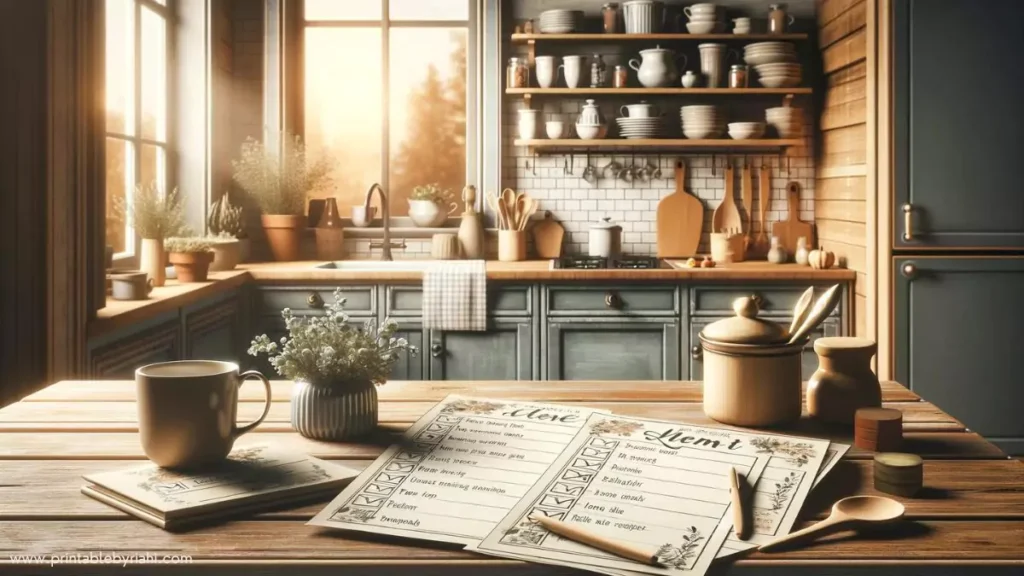Are you caught in a gaze at rooms brimming with clutter, unsure where to start? Trust me, this is a common bind. It’s easy for our belongings to proliferate into unwieldy piles that leave us scratching our heads about how to get things back under control.
The feeling of drowning in things we don’t use or need anymore can be downright paralyzing.
But let’s talk hope and strategy: I stumbled upon a surprisingly straightforward aid – printable home organization checklists. Did you know that orderly environments are actually linked to reduced stress levels and boosted efficiency? In my quest for domestic tranquility, an array of these lists became my secret weapon, transforming the cleanup battle from intimidating to manageable.
They’re about to become your best friends too, simplifying each step as we tackle the chaos together and breathe new life into every nook and cranny of your home. Are you ready for some peace of mind? Let’s dive in!

Key Takeaways
- Printable home organization checklists help reduce stress, save time, and increase efficiency by providing clear steps for decluttering and organizing.
- Declutter tips include sorting items to keep, donate or toss, starting with one area at a time, and using timers for focused cleaning.
- You can use existing storage like under-bed bins or create new spaces in areas like behind doors or under stairs to keep your home tidy.
- Checklists for individual rooms make it easier to clean and maintain order regularly.
- Free printable checklists are available online from resources such as Pinterest, Etsy, and professional organizer websites.
How to Use Printable Checklists to Get Organized
I found that using printable checklists has been extremely helpful in keeping me on track with my organization goals. The benefits of using them are endless, and I’ve learned some great tips for effectively incorporating them into my daily routine.
Benefits of using printable checklists
Printable checklists help me stay on track. They bring order to my daily routine and ensure I don’t forget important tasks.
- Printable checklists save time by outlining exactly what needs to be done. Instead of trying to remember each task, I can focus on completing them one by one.
- They reduce stress because I can see my progress as I check off completed tasks. This visual cue gives me a sense of accomplishment.
- Checklists help me delegate tasks more easily. I can hand over a list to family members, knowing they understand what’s expected.
- Using these lists improves efficiency. With clear steps mapped out, I work through chores faster and with less effort.
- These tools aid in creating a cleaning schedule that works for my lifestyle. I can plan around other commitments without letting household management slip.
- Checklists make decluttering less overwhelming. Breaking it down room by room allows me to tackle the job in manageable sections.
- They promote better time management by showing how much time each task might take. This helps in planning my day more effectively.
- Printable checklists act as guides for an organizing process that may otherwise seem daunting. With step-by-step instructions, nothing gets overlooked.
- Keeping a checklist for daily routines ensures that even underutilized space gets attention over time. No corner stays cluttered for too long.
- Finally, printable checklists encourage consistency in maintaining an organized home. Making them part of everyday life leads to lasting tidy habits.
Tips for effectively using checklists
Transitioning from the benefits of using printable checklists to effectively using them, here are some tips for maximizing their potential:
- Set specific goals for each checklist item to keep focus.
- Prioritize tasks on the checklist to ensure important items are completed first.
- Use the checklist as a visual aid, crossing off completed tasks to track progress.
- Allocate specific time slots for each task to maintain productivity.
- Review and update the checklist regularly to adapt to changing needs.
- Share the checklist with family members or roommates to delegate tasks and foster accountability.
- Integrate the checklist into daily routines to establish consistency and habit formation.
Purging and Categorizing Your Belongings
When it comes to decluttering, it’s crucial to purge and categorize your belongings. This helps create a streamlined and organized living space, making it easier to find what you need when you need it.
Tips for decluttering
Here are some tips for decluttering:
- Sort items into three categories: keep, donate, and discard. This will make the process more manageable.
- Start with one area at a time, such as a closet or a drawer, to avoid feeling overwhelmed.
- Set a timer for small increments, like 15-30 minutes, to stay focused and prevent burnout.
- Be decisive and avoid holding onto items out of guilt or obligation.
- Ask yourself if you have used the item within the past year; if not, it may be time to let it go.
- Enlist help from family members or friends to provide support and make decluttering a collaborative effort.
- Consider the functionality and practicality of each item rather than just its sentimental value.
- Use storage solutions like bins and baskets to organize belongings that you choose to keep.
- Regularly assess your progress and celebrate small victories along the way.
- Keep a positive mindset and visualize how your space will look and feel once it’s clutter-free.
Importance of categorizing possessions
Categorizing possessions is crucial for finding things easily. It saves time and reduces stress by knowing where everything belongs.
Arranging items into specific categories helps in decluttering and organizing the home efficiently, making it easier to maintain a clean and tidy living space. This process also allows for better management of belongings, preventing unnecessary purchases due to misplaced or forgotten items.
By categorizing possessions, I can create a more functional and organized living environment, leading to a sense of control and peace within my home.
Organizing Your Home
Utilizing existing storage spaces is essential to keeping your home organized and clutter-free. I’ll also discuss how you can create additional storage in uncommon places and provide tips for putting belongings away efficiently.
Utilizing existing storage spaces
I use existing storage spaces efficiently by:
- Maximizing vertical space with shelves, hooks, and hanging organizers to store items like bags, hats, or accessories.
- Using under-bed storage bins for out-of-season clothing or extra linens.
- Incorporating storage ottomans or benches that provide seating and a hidden compartment for items like blankets or books.
- Utilizing the backs of doors with hanging organizers for shoes, cleaning supplies, or toiletries.
- Making use of clear plastic bins for easy visibility and stacking capabilities in closets or under sinks.
- Implementing drawer dividers to organize small items such as socks, underwear, or office supplies.
Creating storage in uncommon places
Looking for extra storage space? Try these unconventional areas:
- Inside cabinet doors: Install hooks or racks to hang items like pot lids or cleaning supplies.
- Under the bed: Use storage containers or bags for off-season clothes, shoes, or bedding.
- Overhead space: Add shelves above doorframes or in high closets for less-used items.
- Behind doors: Hang shoe organizers, hooks, or racks to store small items like scarves, belts, or accessories.
- Staircase storage: Utilize the space underneath the stairs with custom-built drawers or shelving units.
- Wall-mounted solutions: Consider pegboards, floating shelves, or magnetic strips for vertical storage in kitchens and workspaces.
Tips for putting belongings away
To put belongings away efficiently, follow these tips:
- Clear the area where you’ll be storing items.
- Organize similar items together for easy access.
- Label storage containers or drawers to know what goes where.
- Utilize vertical space when storing to maximize storage capacity.
- Group frequently used items in easily accessible areas.
- Regularly assess and declutter storage spaces to maintain organization.
- Make use of hooks and baskets for smaller items to keep them tidy.
The Power and Convenience of Printable Home Organization Checklists
Discover the ease and convenience of using printable checklists to keep your home organized. From cleaning schedules to task planning, these free printables can help you streamline your daily routines and maximize efficiency in managing your home.
Examples of checklists for different areas/rooms in the home
I’ve created checklists for various rooms in the house to keep everything organized. Here they are:
- Kitchen Checklist: Ensure all dishes are washed, wipe down countertops, and clean out the refrigerator.
- Bedroom Checklist: Make the bed, put away clothes, and declutter surfaces.
- Bathroom Checklist: Scrub the toilet, wipe down surfaces, and restock toiletries.
- Living Room Checklist: Vacuum or sweep floors, tidy up pillows and blankets, and dust surfaces.
- Home Office Checklist: Organize paperwork, clean electronics, and tidy up desk area.
- Entryway Checklist: Declutter shoes and jackets, organize mail or keys, and wipe down surfaces.
Where to find additional free printables
When you need more free printables to help with your home organization, there are various online resources that offer a wide range of checklists for different areas and purposes. Websites like Pinterest, Etsy, and household management blogs provide an assortment of printable checklists for organizing your home, such as cleaning schedules, meal planning templates, and daily routines.
These platforms also feature downloadable organizers specifically tailored to certain rooms or tasks in the house. Additionally, many professional organizers share free resources on their websites or social media pages that you can easily access and incorporate into your organizational routine.
Making checklists a part of your daily routine
To make checklists part of my daily routine, I incorporate them into my morning or evening rituals. I prioritize tasks and systematically work through them with the help of these lists.
By using printable home organization checklists, I ensure that nothing is overlooked in keeping my home tidy and efficient. Incorporating this simple yet effective strategy helps me stay organized and focused on what needs to be done each day.
I find that utilizing free checklists available online has saved me time and effort in creating my own organizational tools. Additionally, by integrating these step-by-step processes into my daily routine, I have seen a significant improvement in how efficiently I manage tasks both at home and at work.
This has not only streamlined my organizing but also brought noticeable ease to different aspects of my life.
Conclusion
In conclusion, using printable home organization checklists simplifies the process of getting organized. They help in decluttering, categorizing possessions, and utilizing storage spaces efficiently.
By integrating checklists into your daily routine, you can achieve a more organized and efficient life. So start now and take control of your space with these practical step-by-step strategies!
FAQs
1. What are printable home organization checklists?
Printable home organization checklists are a step-by-step tool to help you organize your home and make your life more efficient.
2. How can these checklists help me get organized?
By following organizing tips on the checklist, you will know exactly what to do next, which helps you clean and arrange things without missing any spots.
3. Can I use the checklists for different areas of my house?
Yes! You can print out different lists that give precise steps to tackle each room or space in your house one by one.
4. Are there strategies included in these checklists to keep my home organized?
Certainly! The checklists often include efficiency strategies that guide you on how to maintain order after getting everything organized.







